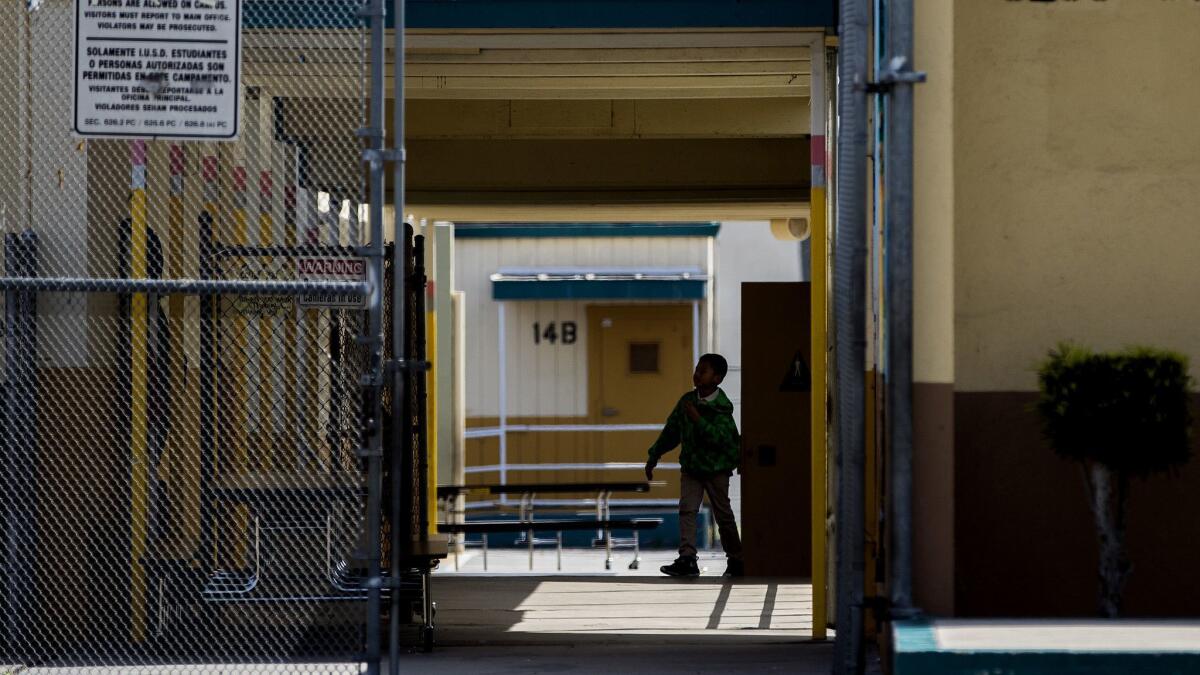Editorial: The real story behind California’s latest school test scores

- Share via
If the California Department of Education’s recent press release about the latest results of its annual standardized tests were graded as an essay, it would get an A for creativity – and obfuscation.
The department started by pointing out that scores on the tests, which are taken in third through eighth grade and again in 11th grade, had “increased further” this year even beyond “gains” in 2017. In fact, the percentage of students who passed the English proficiency test hasn’t even budged by a full point since 2016. Scores were lower in 2015, but those were the first results from the new test, when performance is always low because of the unfamiliarity.
Third- and fourth-graders did somewhat better this year, but 11th-grade scores dropped to slightly below where they were even in 2015 on the English test. The press release mentions the gains in the youngest students’ test results, saying they bode well for the future. Maybe, but we haven’t seen such a pattern in the past.
The department didn’t mention the slide among high school juniors or the stubborn achievement gap between white students and black and Latino ones, though it conceded that more work needed to be done “to make sure all students continue to make progress,” as state Superintendent Tom Torlakson put it. It then went on to list a few “bright spots” around the state in graduation rates and suspensions.
Overnight miracles aren’t expected, but no one should think this year’s test results look promising.
We’d like to hand back the department’s press release with some corrections. Here’s what it should have said:
“Half of our students haven’t passed the English test and less than 40% passed in math. Those numbers have barely budged over the past couple of years. Clearly, California isn’t doing well, and we owe it to our students and the public to delve deeply into where we’re falling short.
“Finding the answer to these problems will require much more information than we have given the public so far. For example, when we say 39% of students met the state’s standards in math, that doesn’t reveal whether most of the rest came pretty close to passing or were far below proficiency levels. We will pore over these numbers, look at the schools where test scores are improving at a more promising clip, and come back to you with answers and suggestions for still-struggling schools.
“And what’s with that abysmal showing by 11th-graders? Those scores are the only ones we have for high school students, so it’s especially frightening to think that we’re moving in the wrong direction with the very students who should be getting ready for college or good jobs at this point.
“It’s nice that third- and fourth-graders showed some decent improvement this year, but we can’t sit back and assume that those early gains will translate into higher scores in middle and high schools down the road. That never happened with the old testing system; lower test scores continued to plague the higher grade levels.
“Under the state’s Local Control Funding Formula, more than $27 billion in extra funding has gone over the last three years to schools with large numbers of disadvantaged kids to help the students with the biggest educational challenges. Yet our achievement gap remains huge. Only one in five black students met the state’s standard for the math test. White students were twice as likely to pass as Latino students. Are schools using the extra money in the right way? A new state law will require school districts to be more transparent about how they use this money, and we at the state will need to take a look at whether it’s really being used to help the intended students.
Enter the Fray: First takes on the news of the minute from L.A. Times Opinion »
“Whether we need to devise more math and reading interventions, provide more tutoring or look at providing extra help with healthcare, safe passage to and from school and other unmet needs that can interfere with academic performance, the leaders of this state are committed to getting to the bottom of this and taking action.”
There, fixed that for you.
Test scores don’t tell you everything you need to know about school performance, but they are a reality check for all the talk about increased graduation rates and reduced suspensions (two easily manipulated numbers). Not counting that first year of the new tests, this is the third year of testing, and the situation is bad.
This is Torlakson’s last year in office, and it should be the last year we see rosy talk about test scores that should be described as disappointing. Overnight miracles aren’t expected, but no one should think this year’s test results look promising.
Follow the Opinion section on Twitter @latimesopinionand Facebook
More to Read
A cure for the common opinion
Get thought-provoking perspectives with our weekly newsletter.
You may occasionally receive promotional content from the Los Angeles Times.










